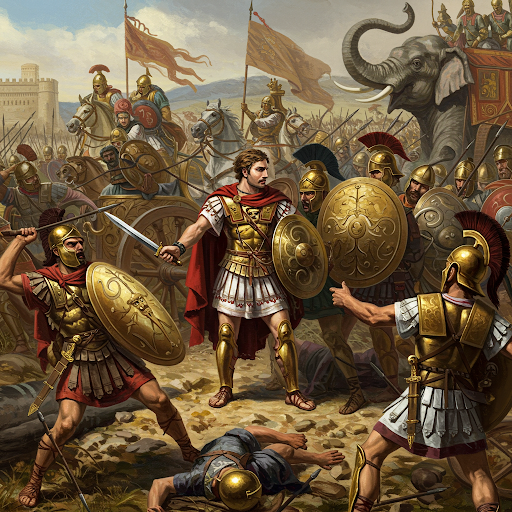Few figures in history have left as profound an impact as Alexander the Great. A military genius, a charismatic leader, and a visionary ruler, Alexander’s short yet eventful life reshaped the ancient world. His conquests created one of the largest empires in history, stretching from Greece to India, and his influence ushered in the Hellenistic era, blending cultures and advancing knowledge. But was he merely a ruthless conqueror, or did he have a deeper vision of unity and progress? This article explores his military campaigns, his administrative policies, and his lasting legacy.
Early Life and Rise to Power
Born in 356 BCE in Pella, Macedonia, Alexander was the son of King Philip II and Queen Olympias. From an early age, he displayed intelligence and ambition, receiving an education under the great philosopher Aristotle. Aristotle’s teachings instilled in Alexander a love for philosophy, science, and the arts, which later influenced his policies as a ruler.
In 336 BCE, Philip II was assassinated, and the 20-year-old Alexander ascended the throne. Facing immediate threats from rebellious Greek city-states, he swiftly crushed uprisings in Thebes, sending a clear message of his authority. With Greece firmly under his control, he turned his attention to his father’s lifelong ambition—the conquest of Persia.
Military Campaigns: The Making of a Legend
Alexander’s military campaigns are among the most extraordinary in history, showcasing his strategic brilliance, adaptability, and relentless ambition.
The Persian Conquest
Battle of Granicus (334 BCE) – Alexander crossed into Asia Minor and won his first major victory against the Persian satraps, proving his ability to defeat the mighty Persian Empire.
Battle of Issus (333 BCE) – In a dramatic confrontation, Alexander’s forces defeated King Darius III, forcing him to flee and securing vast Persian territory.
Siege of Tyre (332 BCE) – Facing a heavily fortified island city, Alexander built a causeway to breach its defenses, demonstrating his engineering ingenuity and determination.
Battle of Gaugamela (331 BCE) – The decisive clash with Darius III saw Alexander’s tactical genius shine, as he employed feigned retreats and superior cavalry maneuvers to secure victory. Darius fled once again, leaving the Persian Empire vulnerable.
The Egyptian Campaign
After taking Egypt without resistance, Alexander was hailed as a liberator and declared Pharaoh. He founded Alexandria, which would become a center of learning and culture for centuries. His time in Egypt reinforced his vision of blending Greek and Eastern traditions.
The Indian Campaign
Battle of the Hydaspes (326 BCE) – One of Alexander’s most challenging battles, fought against King Porus in modern-day Pakistan. Despite facing war elephants, Alexander triumphed, displaying his adaptability to new combat scenarios.
The Mutiny at the Hyphasis River – His army, exhausted and unwilling to march further into India, forced Alexander to turn back. This marked the beginning of the end of his campaign.
Alexander’s Vision: More Than Just a Conqueror?
Beyond his military exploits, Alexander sought to create a unified empire blending Greek and Eastern cultures. This vision was reflected in several policies:
Cultural Fusion (Hellenization) – He encouraged intermarriage between Greeks and Persians, adopted Persian customs, and spread Greek language, art, and philosophy across his empire.
Founding Cities – Over 20 cities named Alexandria were established, becoming trade and cultural hubs that preserved Greek knowledge and promoted diverse intellectual exchanges.
Religious Tolerance – Unlike many conquerors, Alexander respected local traditions and often participated in native religious ceremonies, which helped maintain stability in his empire.
Administrative Reforms – He incorporated local officials into his government, ensuring smoother governance and fostering loyalty.
The Sudden End and the Fragmentation of an Empire
In 323 BCE, at the age of 32, Alexander died in Babylon, possibly due to fever, poisoning, or an undiagnosed illness. His sudden death led to the rapid fragmentation of his empire as his generals, known as the Diadochi, fought for control. The empire split into several Hellenistic kingdoms, including the Seleucid Empire, the Ptolemaic Kingdom of Egypt, and Macedon.
Alexander’s Lasting Legacy
While his empire did not survive intact, Alexander’s influence endured for centuries:
Hellenistic Culture – The blending of Greek, Egyptian, Persian, and Indian cultures led to advancements in science, mathematics, philosophy, and art.
Influence on Rome – The Roman Empire admired and emulated Alexander’s military strategies and governance, shaping their own imperial expansion.
Legends and Myths – His life inspired countless legends, from medieval romances to Islamic and Persian historical traditions.
Conclusion: Conqueror, Visionary, or Both?
Was Alexander simply a brilliant warlord, or was he a visionary seeking to unite the known world? While his methods were often ruthless, his impact on history is undeniable. His conquests reshaped civilizations, and his vision of cultural integration influenced the course of history. Today, he remains one of the most studied figures in history, embodying both the ambition and complexities of leadership.









